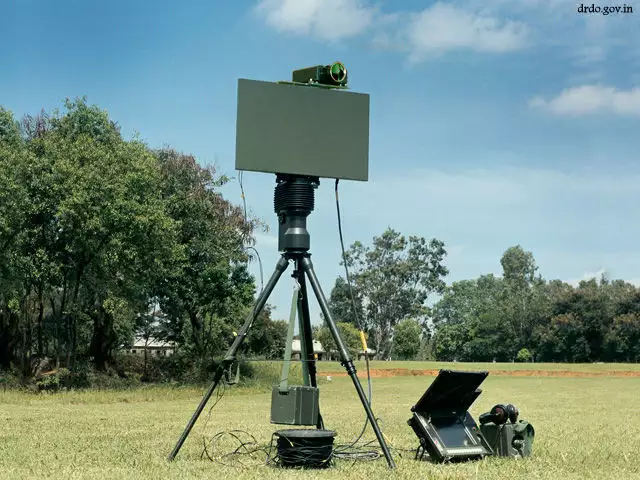The PJT-531 Battlefield Surveillance Radar – Short Range (BFSR-SR) is a cutting-edge man-portable 2D short-range battlefield and perimeter surveillance radar system developed by the Indian Defence Research and Development Organisation (DRDO). Designed to enhance the Indian Army’s surveillance capabilities, the BFSR-SR is a result of collaboration between the Electronics and Radar Development Establishment (LRDE) in Bengaluru and Bharat Electronics Limited (BEL), which handles its manufacturing.
Development and Background: In response to the challenges posed by infiltration and heightened surveillance requirements in the aftermath of the Kargil War, the Indian Army initiated the development of electronic sensors to bolster their reconnaissance capabilities. The BFSR-SR project was initiated to create a compact, high-performance radar system for this purpose. Some Battle Field Surveillance radars (SR) were initially imported from Israel while the indigenous BFSR-SR was under development.
Led by Dr. S. Varadarajan at LRDE, the development began in 2000 and demonstrated a unique approach of concurrent engineering with private sector involvement, marking a pioneering step in Indian defense programs. The radar was quickly brought into production, with the involvement of private firms supplying various components.
Features and Specifications: The BFSR-SR is characterized by its portability and adaptability. Weighing around 30 kg, it can be effectively operated by two or three-man teams. The radar operates in the J band frequency range (10 to 18/20 GHz) and employs a fully coherent Pulse Doppler radar system. With a low peak power of 5W, it ensures a low probability of intercept (LPI), making it challenging for enemy sensors to detect.
The radar’s operational modes include Surveillance/Scanning, acquisition, tracking/classification, and manual or automated standby modes. It is equipped with Digital Pulse Compression Technology developed in-house by LRDE, enhancing its LPI attributes and accuracy. The BFSR-SR’s key components include a mounting tripod, an antenna/electronics assembly, rechargeable 24 V batteries, and an integrated Control and Display Unit (CDU).
The radar offers excellent flexibility with networking capabilities, allowing up to 10 radars to be networked for expanded coverage. It also incorporates third-generation thermal imaging technology, operating in the Mid-wavelength Infrared spectrum, enhancing its day and night viewing capabilities.
Applications and Deployment: The BFSR-SR has been extensively employed by the Indian Army in border areas, particularly along the Line of Control (LoC) in Jammu and Kashmir, to prevent infiltration and ensure border security. Additionally, it finds utility in battlefield surveillance, intelligence gathering, and protection of sensitive sites and facilities. The system’s adaptability allows for vehicle or mast-mounted configurations to improve detection capabilities.
Foreign Sales and Reach: BFSR-SR has garnered international recognition and interest, with countries like Indonesia, Sudan, and Mozambique placing orders for these radar systems. With its cost-effectiveness and advanced features, the BFSR-SR has been promoted by BEL in global defense markets.
Performance:
- Range:
- Detection Range:
- Crawling man: 500 m
- Walking man: 2 km (1.2 mi)
- Group of people: 7 km (4.3 mi)
- Light vehicle: 10 km (6.2 mi)
- Heavy vehicle: 14 km (8.7 mi)
- Range accuracy: 20m rms
- Range resolution: 50 m
- Speed: 0.9 m/s to 90 km/h
Azimuth & Elevation:
- Elevation Coverage: -40 to +15° (remotely settable)
- Azimuth sector scan: 30 to 180°
- Azimuth accuracy: 0.5° rms
- Azimuth resolution: better than 4°
- Track while Scan: 50 targets
Technical Specifications:
- Instrumented Range: 18 km (11 mi)
- Frequency Band: J band, 21 frequencies
- Transmitter Type: Solid state
- Receiver Type: Super heterodyne
- Antenna Type: Micro-strip Patch array
Operation:
- Modes of operation: Surveillance and tracking
- Target Identification: Using Doppler tones
- Rotation Rate: Low, Medium, High
Display:
- Control & display unit: Customized, portable, IBM PC, compatible with Windows NT operating system
- Display type: 10.4″ LCD colour
- Display modes: PPI or B-scope
- External interface: RS232C, LAN
Power & Reliability:
- Weight: 30 kg (excluding accessories)
- Power supply: 24 V DC nominal
- Power consumption: 80 W
- Operating temperature: -20 to +55 °C
- MTBF: 1500 hrs
- Operational Altitude: Up to 16,000 feet (4,900 m)
Feel free to let me know if there’s anything else you would like to add or modify in the encyclopedia page!
